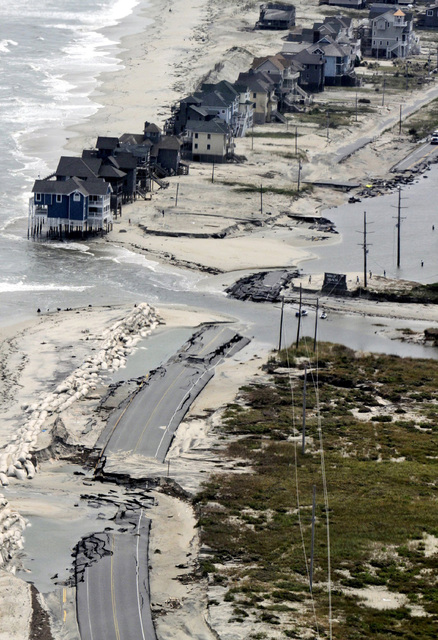Dutch experience shows that America’s coastal cities don’t have to drown
ALMERE, Netherlands — A 68-year-old Dutch man with an impossibly long name and a small dog is walking along the edge of a new lake when he stops and points upward.
“Naturally, the water would be up there, you know,” says Erik van Tienhoven van Weezel, pointing at an invisible spot about 10 feet above his head. “We live under the sea level, by quite a bit. And we know the water is a little higher each year. Do we lose sleep over what could happen if the dikes break? Do we worry about how we will survive as the climate gets warmer and the sea gets even higher? No. We have adapted for centuries. We will continue to adapt.”
As far as Dutch adaptation to rising water goes, van Tienhoven van Weezel is at ground zero. Almere, a city of 190,000, used to be covered by the Zuiderzee, a well-known bay of the North Sea that once cut a 60-mile hole out of the northern part of the Netherlands. But the Netherlands has been using windmills and dikes and a network of canals for centuries to expand the tiny nation into the often violent sea, and the Zuiderzee is now dry land. Almere is an example of Dutch success; about 15 percent of the Netherlands used to be covered by ocean waters.
And that lesson, say European climatologists, is an important one for the United States, where studies indicate that large areas of coastal cities such as Miami are likely to disappear under rising seawaters, not in centuries, but in decades. The key, they say, is for U.S. politicians to stop debating the cause of sea level rise and start planning and funding the works that can stave it off.
“Adapt or die,” says the T-shirt of a man walking through Almere’s town square. The initials NAP are bricked into a staircase nearby, marking where the Normal Amsterdam Peil, or normal Amsterdam water level, would be, way above his head, were it not for the pumps and dikes that hold back the sea.
In Potsdam, Germany, climate scientist Anders Levermann is chatting about how the world will change in a future of rising seas when he is asked about Miami.
“Miami? Miami is already doomed,” he says.
The sea level expert at Germany’s Potsdam Institute for Climate Impact Research, pauses, then starts to correct himself. “That’s probably not fair,” he says. “Miami is, ah. … No, it’s just doomed.”
Among climate scientists, Miami has earned the nickname “New Atlantis,” a reference to the legendary lost continent that slipped below the sea. But Miami is hardly alone among at-risk cities. A World Bank study listed it second among cities facing a risk of “overall cost of damage.” It trailed only Guangzhou in southern China, and it’s expected to fare only a bit better than New York and New Orleans.
The list of cities facing issues over the next 100 years rings the United States. An interactive map on the website of the U.S. climate scientist group ClimateChange gives an idea of what might be in store over the next 100 years.
South Carolina, for example, would see a sea level rise of 4 feet within 100 years. Hilton Head Island would be further isolated. The Waccamaw River would spread out, leaving southern Myrtle Beach as a peninsula. Texas might see a 3-foot rise before the end of this century, flooding sections of Galveston and other coastal lowlands.
In Miami, the sea is expected to rise a foot perhaps as soon as 2040, and reach 5 feet as early as 2080. At that point, the water starts taking over low-lying areas along the Miami River. Within 100 years, it could wash over most of Miami Beach and start swamping neighborhoods along the river.
Such increases are further off on the West Coast, though not by much.
Too far in the future to take seriously? The Dutch have already approved spending a billion dollars a year for the next 100 years to deal with the threat of the sea.
“This is not a time, yet, for panic,” Levermann says. “This is, however, a time to be making plans, for deciding what we are going to do to protect people and cities and nations around the world from the rising water. We do have options. But we need to be making plans.”
Paul Olsen, a sea level expert at Old Dominion University in Norfolk, Va., is running a program that’s looking at how the United States can adapt. He emphasizes that while the water is rising, there are options. Current U.S. strategies, he says, are “fledgling.”
“They don’t have the funding or the national attention that’s needed,” he says. “I don’t think we’re ignoring it. We’ve had other priorities. We’ve focused on terrorism, and al-Qaida and ISIL (the Islamic State). These are the wolves that are closest to the sled. Sea level rise? That wolf is a long ways away. But he is coming.”
The solution will rely on an overarching federal plan — one that does not yet exist — but also on local and state planning. Coastal cities, he believes, have four options: Defend, adapt, retreat and avoid.
“Defend” means sea walls, keeping the sea out. The Dutch approach. “Adapt” means creative thinking, raising buildings, raising neighborhoods, living with canals. This is Venice. “Retreat” is simply heading inland. Already, on a small scale, Alaskan Inuit tribes are employing this strategy. They don’t have the means to keep the sea at bay, so they take advantage of one of the great advantages of the United States, lots of higher ground. “Avoid” is simply making sure that new construction, roads, sewer and water systems are built with sea level rise in mind.
Incredible things are possible. Consider the lake surrounding Almere. It is a freshwater lake, separated from the North Sea by a 16-mile-long dike, one that was built into the sea. Elsewhere, Dutch water defenses include robotic dams that move into place only when needed, and that rise and fall with the water to protect the nation during storms. These defenses are the result of centuries of practice, and they have taken decades to plan and years to construct.
To understand how completely a nation can commit to this sort of project, consider the Netherlands. The Dutch have been fighting to hold back the water since the end of the Iron Age, 3,000 years ago.
In the 1700s a wood-eating mollusk started destroying Dutch dikes at an astonishing rate, so the dikes were converted to stone and clay. Windmills churned night and day to pump out excess water. As land was recaptured, it became a patchwork of fertile fields and canals for drainage. It even fed the global image of the nation, most famously in Mary Mapes Dodge’s story of the Little Dutch Boy, who plugged a leaking dike with his finger.
That system held the nation together until 1953, when rising seas and flooding rivers led to bursting dikes and a flood that submerged half the country and left 1,800 dead.
The dikes were rebuilt, stronger and bigger. Today the Netherlands spends almost 0.2 percent of its annual economic output — about $1.1 billion — on what it calls “water defense.” Converting that to an equivalent American amount would be about $35 billion a year. For comparison, that’s about 6 percent of the 2015 U.S. defense budget of $560 billion.
“What we, the Dutch, are doing is quite rational,” says Jarl Kind, a water economist for the Dutch Delta Commission, which oversees keeping the nation dry. “There are two ways to deal with the threat of floods: Wait for the floods and repair what is lost. Or build an infrastructure to mitigate flood damage. Given what we could lose, it’s not a lot of money to spend.”






